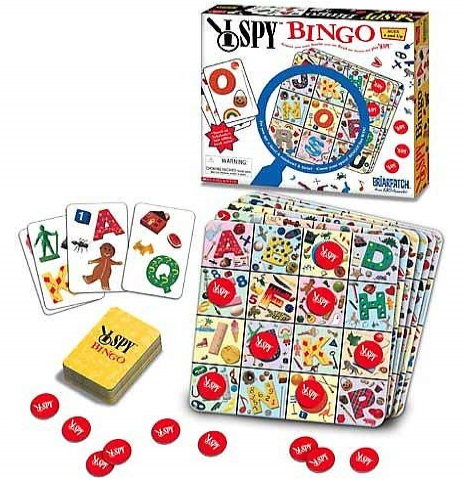 |
| I SPY Bingo - Bingo like only I SPY can do it |
These I SPY Bingo cards are covered with I SPY's classic figure ground objects. Yup, they're busy, maybe too busy for some. There are several ways to play and two different levels of difficulty.
The six I SPY bingo cards are 2-sided, each side has 16 squares and no free space. Both sides have a letter in each square surrounded by three or four small objects. One side has light colored backgrounds and the alphabet is in ABC order. Each item in a square starts with the letter in that square (see image above). This is considered the easier side because you can just look for the first letter of the object to find the square with the object.
The other side has a white background and the alphabet is not in ABC order. The objects in each square may or may not start with the letter. This is considered the harder side as you may have to search the whole card to find one object.
There is one alphabet calling card for each letter of the alphabet, 26 total. The image above shows calling cards that are printed on one side for the game and the other side is printed with the game name. My cards are printed with objects on a light blue colored background on one side for the first game, and with objects printed on a white background on the other side for the second game.
There are 50 red tokens.
I SPY is a company that is well known for their figure ground games and books. I have used many of them in therapy. If you would like to read more about I SPY products, check out my post on I SPY Games.
Object:
Create a row of four tokens on your card, horizontally, vertically or diagonally.
Set up:
Give each player a bingo card. Shuffle the playing cards and place them in a face-down pile near the players. Place the tokens where all players can reach them.
Play:
- Version 1 - Use the bingo cards with the colored backgrounds and the blue playing cards. Players take turns drawing a card and calling the letter that is on the cards. Place tokens on squares that you match. Play until someone has four in a row.
- Version 2 - Use the bingo cards with the colored backgrounds and the blue playing cards. Call out one object on the card instead of the letter. Players can sound out the first letter of the object and look for that letter. Place tokens on squares where you find a match. Play until someone has four in a row.
- Version 3 - Use the white side of the bingo and playing cards. Play as in version 2, calling out one object. The object may or may not be in a square with the letter that the object starts with so you may have to search the whole card. Place tokens on squares where you find matches. Play until someone has four in a row.
Try this:
- Play with just the bingo cards with the colored background. Use the colored background side and name each object so that it starts with the letter. Some may not be obvious. For instance that is a snake on the V square, so it is a viper. Or a butterfly in the Y square does not match, but when you describe it as a yellow butterfly, then it does.
- Play with just the bingo cards with the white background. Name each item and decide which ones do start with the letter in that box and which ones don't.
- Watch for a bingo in only one plane at a time if the player cannot watch horizontal, vertical and diagonal all at the same time. When they get good in one direction, then add the second, and finally the third.
- Draw a grid on a piece of paper and color in the squares for win in a particular orientation if the individual is not used to playing and will need a reminder what they are looking for.
- Watch for a bingo in different orientations to mix it up a little, such as four outside corners or four inside corners. There are not enough tokens to make a frame on six cards, but you could use other things you have around as tokens if you wanted to go there.
- Practice finding bingo wins on a card before playing if the individual is not used to playing bingo. Place several tokens on a card and embed one win somewhere on the card. Ask the player to find the bingo win. Practice several times, embedding wins in different orientations.
- Just use the playing cards and lay them in a line in alphabetical order.
- Place several of the playing cards in a grid on the table top. Call one item and ask the player to find that item. Or call an object and sound out the first letter for a quicker find. Start with fewer cards and increase the number of cards as the player improves.
- Hold several tokens in your hand at the same time. Slide them one at a time to the fingertips to place as you need them.
- Work on visual discrimination, figure ground, visual closure, fine motor, in-hand manipulation, manual dexterity, beginning sounds, executive functioning skills, socialization skills, process skills, play and leisure exploration and participation
In the box: 6 double-sided Bingo cards, 26 double-sided calling cards, 50 tokens
If you are interested in purchasing this game or just want more information, click on the image below.


No comments:
Post a Comment
Thank you for taking the time to comment.